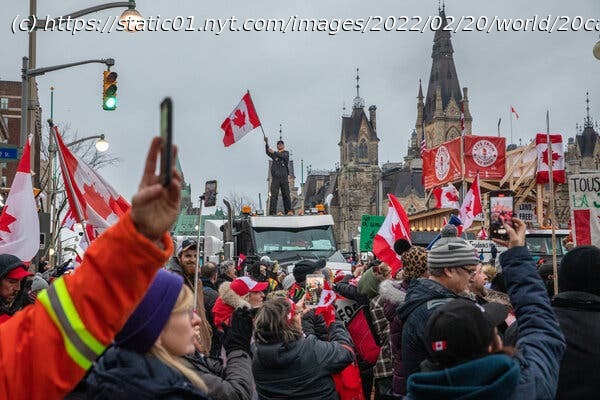The demonstrators were passionate, organized and supported financially, but such spontaneous movements often have a tough time converting their energy into real change.
A cavalcade of big rigs rumbled into the Canadian capital, blocked major streets, drew thousands of supporters, enraged residents and captured the attention of a shocked nation for three weeks. Now they’re gone, leaving Canadians to grapple with some high stakes questions about their country’s political future. Was the occupation an aberration, or was it the beginning of a more fundamental shift in the country’s political landscape? Did their chaotic blockade alienate the public so much that the movement has no shot at a future, or did it form the base for a lasting political organization? “There is a worry, and it’s been expressed in all kinds of ways, that this protest movement will become something much more significant and much more sustained,” said Wesley Wark, a senior fellow at the Center for International Governance Innovation, a Canadian public policy group. “It was given terrific oxygen to spread its message.” The moment is uniquely tied to the pandemic: Protesters demanded an end to all government pandemic measures. But it is also part of a broader trend. Social media was a driving force behind street protests of the past decade or so, uniting multitudes in occupations from Zuccotti Park in New York to Gezi Park in Istanbul. But research has shown that such movements often have a tough time converting their energy into real change. By Sunday afternoon, streets in Ottawa that had been clogged with trucks, makeshift canteens and noisy protesters were largely empty except for police vehicles. A swath of downtown had been fenced off. A protester compound that had occupied a baseball stadium’s parking lot had been cleared — though about two dozen heavy trucks and a cluster of other vehicles reconvened about 100 kilometers outside the city. During their three-week occupation, much about the protests alienated Canadians. At a border blockade in Alberta, police seized a large cache of weapons and charged four protesters with conspiring to murder police officers. But demonstrators also saw much of the disruption they caused as a tactical victory. One contingent in Windsor, Ontario, blocked a key bridge between Canada and the United States for a week, forcing auto plants to scale back production and disrupting about $300 million a day in trade. From the beginning, they caught law enforcement flat-footed. Some truckers said in interviews that they were surprised at being allowed to stay in the first place, and the city’s police chief resigned in response to the public anger over the sluggish pace at which the authorities moved to dislodge them.
Домой
United States
USA — Financial After Trucker Protest, Canada Grapples With a Question: Was It a Blip,...






